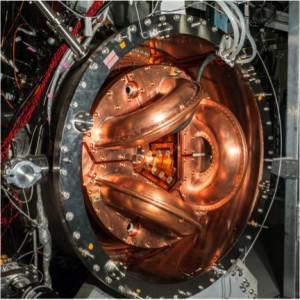UW Fusion Reactor Concept Could Be Cheaper Than Coal

U of Washington The UW’s current fusion experiment, HIT-SI3. It is about one-tenth the size of the power-producing dynomak concept.
Perhaps the biggest roadblock to adopting fusion energy is that the economics haven't penciled out. Fusion power designs aren't cheap enough to outperform systems that use fossil fuels such as coal and natural gas.
University of Washington engineers hope to change that. They have designed a concept for a fusion reactor that, when scaled up to the size of a large electrical power plant, would rival costs for a new coal-fired plant with similar electrical output.
The team published its reactor design and cost-analysis findings last spring and will present results Oct. 17 at the International Atomic Energy Agency's Fusion Energy Conference in St. Petersburg, Russia.
“Right now, this design has the greatest potential of producing economical fusion power of any current concept,” said Thomas Jarboe, a UW professor of aeronautics and astronautics and an adjunct professor in physics.
The UW's reactor, called the dynomak, started as a class project taught by Jarboe two years ago. After the class ended, Jarboe and doctoral student Derek Sutherland – who previously worked on a reactor design at the Massachusetts Institute of Technology – continued to develop and refine the concept.
The design builds on existing technology and creates a magnetic field within a closed space to hold plasma in place long enough for fusion to occur, allowing the hot plasma to react and burn. The reactor itself would be largely self-sustaining, meaning it would continuously heat the plasma to maintain thermonuclear conditions. Heat generated from the reactor would heat up a coolant that is used to spin a turbine and generate electricity, similar to how a typical power reactor works.
“This is a much more elegant solution because the medium in which you generate fusion is the medium in which you're also driving all the current required to confine it,” Sutherland said.
There are several ways to create a magnetic field, which is crucial to keeping a fusion reactor going. The UW's design is known as a spheromak, meaning it generates the majority of magnetic fields by driving electrical currents into the plasma itself. This reduces the amount of required materials and actually allows researchers to shrink the overall size of the reactor.
Other designs, such as the experimental fusion reactor project that's currently being built in France – called Iter – have to be much larger than the UW's because they rely on superconducting coils that circle around the outside of the device to provide a similar magnetic field. When compared with the fusion reactor concept in France, the UW's is much less expensive – roughly one-tenth the cost of Iter – while producing five times the amount of energy.
The UW researchers factored the cost of building a fusion reactor power plant using their design and compared that with building a coal power plant. They used a metric called “overnight capital costs,” which includes all costs, particularly startup infrastructure fees. A fusion power plant producing 1 gigawatt (1 billion watts) of power would cost $2.7 billion, while a coal plant of the same output would cost $2.8 billion, according to their analysis.
“If we do invest in this type of fusion, we could be rewarded because the commercial reactor unit already looks economical,” Sutherland said. “It's very exciting.”
Right now, the UW's concept is about one-tenth the size and power output of a final product, which is still years away. The researchers have successfully tested the prototype's ability to sustain a plasma efficiently, and as they further develop and expand the size of the device they can ramp up to higher-temperature plasma and get significant fusion power output.
The team has filed patents on the reactor concept with the UW's Center for Commercialization and plans to continue developing and scaling up its prototypes.
Other members of the UW design team include Kyle Morgan of physics; Eric Lavine, Michal Hughes, George Marklin, Chris Hansen, Brian Victor, Michael Pfaff, and Aaron Hossack of aeronautics and astronautics; Brian Nelson of electrical engineering; and, Yu Kamikawa and Phillip Andrist formerly of the UW.
The research was funded by the U.S. Department of Energy.
###
For more information, contact Jarboe at jarboe@aa.washington.edu or 206-685-3427 and Sutherland at das1990@uw.edu.
Media Contact
All latest news from the category: Power and Electrical Engineering
This topic covers issues related to energy generation, conversion, transportation and consumption and how the industry is addressing the challenge of energy efficiency in general.
innovations-report provides in-depth and informative reports and articles on subjects ranging from wind energy, fuel cell technology, solar energy, geothermal energy, petroleum, gas, nuclear engineering, alternative energy and energy efficiency to fusion, hydrogen and superconductor technologies.
Newest articles

Silicon Carbide Innovation Alliance to drive industrial-scale semiconductor work
Known for its ability to withstand extreme environments and high voltages, silicon carbide (SiC) is a semiconducting material made up of silicon and carbon atoms arranged into crystals that is…

New SPECT/CT technique shows impressive biomarker identification
…offers increased access for prostate cancer patients. A novel SPECT/CT acquisition method can accurately detect radiopharmaceutical biodistribution in a convenient manner for prostate cancer patients, opening the door for more…

How 3D printers can give robots a soft touch
Soft skin coverings and touch sensors have emerged as a promising feature for robots that are both safer and more intuitive for human interaction, but they are expensive and difficult…





















